

Wood Pulp, World's New Wonder Material. Why wood pulp is world's new wonder material - tech - 23 August 2012. THE hottest new material in town is light, strong and conducts electricity.

What's more, it's been around a long, long time. Nanocrystalline cellulose (NCC), which is produced by processing wood pulp, is being hailed as the latest wonder material. Japan-based Pioneer Electronics is applying it to the next generation of flexible electronic displays. IBM is using it to create components for computers. Even the US army is getting in on the act, using it to make lightweight body armour and ballistic glass. To ramp up production, the US opened its first NCC factory in Madison, Wisconsin, on 26 July, marking the rise of what the US National Science Foundation predicts will become a $600 billion industry by 2020. So why all the fuss? "It is the natural, renewable version of a carbon nanotube at a fraction of the price," says Jeff Youngblood of Purdue University's NanoForestry Institute in West Lafayette, Indiana. More From New Scientist The creepy crawly story of life on Earth (New Scientist) New 'super-paper' is stronger than cast iron - tech - 06 June 2008.
Punching your way out of a paper bag could become a lot harder, thanks to the development of a new kind of paper that is stronger than cast iron.
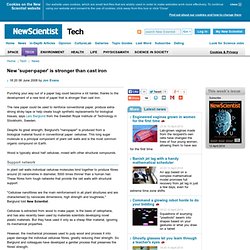
The new paper could be used to reinforce conventional paper, produce extra-strong sticky tape or help create tough synthetic replacements for biological tissues, says Lars Berglund from the Swedish Royal Institute of Technology in Stockholm, Sweden. Despite its great strength, Berglund's "nanopaper" is produced from a biological material found in conventional paper: cellulose. This long sugar molecule is a principal component of plant cell walls and is the most common organic compound on Earth. Under Secretary Sherman Unveils Nanocellulose Production Facility. The U.S.

Forest Service Forest Products Laboratory recently opened a $1.7 million production facility for renewable, forest-based nanomaterials. This facility is the first of its kind in the United States and one that positions the laboratory as the country’s leading producer of these materials, also called nanocellulose. Nanocellulose is simply wood fiber broken down to the nanoscale.
For perspective, a nanometer is roughly one-millionth the thickness of an American dime. Materials at this minute scale have unique properties; nanocellulose-based materials can be stronger than Kevlar fiber and provide high strength properties with low weight. Forest Product Lab chemical engineer Rick Reiner (right) shows Under Secretary Sherman the new nanocellulose pilot plant. USDA Natural Resources and Environment Under Secretary Harris Sherman was the keynote speaker for this grand opening event, and he was encouraged by the advances being made in the field of wood nanotechnology at the FPL. Nanocellulose: A cheap, conductive, stronger-than-Kevlar wonder material made from wood pulp. What’s brown and sticky, lightweight, flexible, stronger than steel, stiffer than Kevlar, and conducts electricity?

Nanocellulose. Oh, isn’t actually brown and sticky either: it’s transparent. Nanocellulose is a new wonder material that is simply plant matter that has been carefully smashed to pieces, and then reformed into neatly-woven nanoscale crystals and fibers. You generally start with wood pulp, remove any non-cellulose impurities (such as lignin) using a homogenizer, and then gently beat the mixture to separate each of the cellulose fibers. Nanocellulose Has Strong Potential For Many Technologies. Amazing Wood Nanomaterial: See-Through, Stronger Than Steel, Conducts Electricity. Forest Products Laboratory - USDA Forest Service. Forest Products Laboratory - USDA Forest Service. The United States and other nations will see numerous benefits from the commercialization of wood-derived cellulosic nanomaterials, as they have many desirable characteristics.
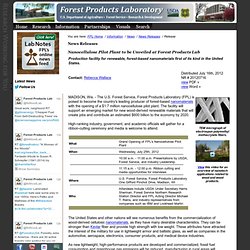
They can be stronger than Kevlar fiber and provide high strength with low weight. These attributes have attracted the interest of the military for use in lightweight armor and ballistic glass, as well as companies in the automotive, aerospace, electronics, consumer products, and medical device industries.
Forest Products Laboratory - USDA Forest Service. Commercial playing: John Stofflet (News Anchor): Rachael, thank you.
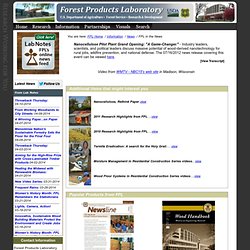
The name may not ring a bell and the science may not make sense to all of us, but a new Madison Forest Products facility, could be a game changer that affects each and every one of our lives. A nanocellulose pilot plant could help fatten all of our wallets and people are here from around the country checking it out. NBC 15 Cris Wooder reports. Cris Woodard (Anchor/Reporter): Massive Forest Fires. Harris Sherman (Under Secretary of Agriculture for Natural Resources and the Environment): Potentially a game changer. Today's the ribbon cutting at the Forest Products Laboratory's Nanocellulose Pilot Plant. Alan Rudie (FPL Project Leader): Forest Products Laboratory - USDA Forest Service. Nanotechnology is a multi-disciplinary field of applied science and technology.
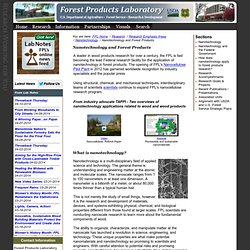
The general theme is understanding and engineering matter at the atomic and molecular scales. The nanoscale ranges from 1 to 100 nanometers in at least one dimension. TAPPI Nanocellulose Video - Rethink Paper. Nanocellulose. Nanocellulose Nanocellulose can also be obtained from native fibers by an acid hydrolysis, giving rise to highly crystalline and rigid nanoparticles (generally referred to as nanowhiskers) which are shorter (100s to 1000 nanometers) than the nanofibrils obtained through the homogenization route.
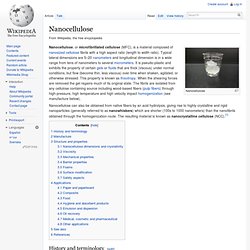
The resulting material is known as nanocrystalline cellulose (NCC).[1] History and terminology[edit] The terminology microfibrillated/nanocellulose or (MFC) was first used by Turbak, Snyder and Sandberg in the late 1970s at the ITT Rayonier labs in Whippany, New Jersey, USA to describe a product prepared as a gel type material by passing wood pulp through a Gaulin type milk homogenizer at high temperatures and high pressures followed by ejection impact against a hard surface. As of August 2012, NCC was produced in a factory operated by CelluForce, producing one ton per day, and by a just-opened facility operated by the US Forest Service.[7] Manufacture[edit] Structure and properties[edit] Foams[edit]
Canadian Forest Service : Nanocrystalline cellulose. Amazing Innovations: Is Wood Pulp The World's New Wonder Material? Designers and scientists are just now realizing that one of the strongest and lightest materials around has been under our noses all along.

Nanocrystalline cellulose (NCC for short), made by processing wood pulp, is being called the new wonder material and Pioneer Electronics, a Japanese corporation has started using NCC in their latest line of electronic devices. IBM has also started using NCC for computer components, and even the US Army is catching on, using NCC to design lightweight body armor. Follow Us The first American NCC factory opened in Madison Wisconsin just last month on July 26, but the US National Science Foundation is already predicting that wood pulp could become a $600 billion industry by 2020.